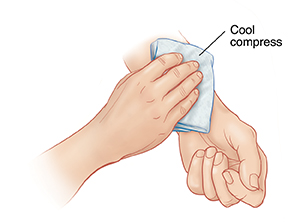Understanding Contact Dermatitis
Contact dermatitis is a common type of skin rash. It’s caused by something that touches the skin and makes it irritated and inflamed. The rash often appears 1 to 2 days after contact was made with the substance. It can take place on any part of the body, such as the face, neck, hands, arms, and legs. Contact dermatitis isn't spread from person to person.
How to say it
CAHN-tact der-muh-TI-tihs
What causes contact dermatitis?
It’s caused by something that irritates the skin or that causes an allergic reaction on the skin. This includes:
-
Plant oils in poison ivy, oak, and sumac
-
Chemicals in laundry detergent, household cleaners, solvents, and glue
-
Chemicals in makeup, soap, perfume, acne cream, and hair products
-
Certain medicines, such as neomycin, bacitracin, benzocaine, and thimerosal
-
Metals, such as nickel, found in some jewelry and watch bands
-
The sticky material on the back of bandages and tape (adhesive)
-
Things that can cause tiny breaks in the skin, such as wood, fiberglass, metal tools, and plant thorns
-
Rubber latex in surgical gloves and other medical supplies
Allowing the skin to stay damp for long periods of time can also cause it. Examples include washing your hands too often or working with wet materials.
Symptoms of contact dermatitis
Symptoms can include skin that's:
-
Blistered
-
Crusty from fluids that oozed out of blisters
-
Burned
-
Cracked
-
Dry
-
Itchy
-
Painful
-
Red
-
Rough, thickened, and leathery
-
Swollen
-
Warm
Treatment for contact dermatitis
 |
| A cool, moist compress can help reduce itching. |
Treatment can help relieve itching and reduce inflammation. If the cause of the problem is avoided, the rash should go away in a few days to a few weeks. Treatments include:
-
Steroid cream or ointment. You can apply this medicine several times a day on clean skin.
-
Cool, moist compress. Use a clean damp cloth. Put it on the area for 20 to 30 minutes, 5 to 6 times a day for the first 3 days.
-
Oral corticosteroid. Your healthcare provider may prescribe this medicine if you have severe skin symptoms on a large part of your body. Your provider may give you a steroid injection instead of pills.
-
Oral antihistamine. This medicine can help reduce itching. It may also make you drowsy.
-
Colloidal oatmeal bath. Soaking in water with colloidal oatmeal can help soothe skin.
-
Plain (without medicine) cream, lotion, or ointment. These can help soothe and protect your skin.
Living with contact dermatitis
Talk with your provider about what may have caused your contact dermatitis. If it's an ongoing problem, patch testing may help you figure out what caused the rash. Once you learn what caused your rash, make sure to avoid that substance.
If you come into contact with it again, wash your skin right away. If you can’t avoid the substance, wear gloves or other protective clothing before you touch it. Wash the clothing you were wearing. This is because the substance you're allergic to may stay on them until it's washed off.
Pets can also pass on allergens, such as oil in poison ivy, from the plant to your skin. Bathe pets if you suspect they've been in contact with an allergan. Or use a cream, lotion, or ointment to protect your skin.
When to call your healthcare provider
Call your provider right away if you have any of these:
Online Medical Reviewer:
Michael Lehrer MD
Online Medical Reviewer:
Raymond Kent Turley BSN MSN RN
Online Medical Reviewer:
Tennille Dozier RN BSN RDMS
Date Last Reviewed:
5/1/2022
© 2000-2024 The StayWell Company, LLC. All rights reserved. This information is not intended as a substitute for professional medical care. Always follow your healthcare professional's instructions.